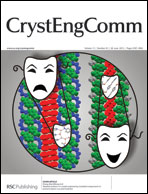Structural analysis reveals the presence of supramolecular chains in a series of eight N-arylamino 1,2,3-triazole esters, which differ only in the nature of the substituent (Y) of the terminal aryl ring. In each of 1 (Y = 4-H), 3 (4-Cl), 4 (4-Br), 5 (4-I) and 6 (4-OMe), the chains are sustained by N–H⋯N hydrogen bonding. In 2 (Y = 4-F) and 8 (Y = 2,5-Cl2), the chains are mediated by alternating N–H⋯N and N–H⋯O hydrogen bonding, whereas in 7 (Y = 4-NO2) the chain is sustained by N–H⋯O hydrogen bonding only. While the differences in the adopted supramolecular motifs are qualitatively correlated with the electronegativity of the Y substituents, no quantitative correlations could be made with the electronic structures of the theoretical gas-phase molecules. Two distinct patterns of crystal packing are observed, with the first of these being based on the inter-digitation of layers, comprised of supramolecular chains and connections of the type C–X⋯π(aryl) between them for 3–5 and 8; only weak off-set edge-to-edge π⋯π interactions were noted in the case of 1. A common feature of the zigzag chains in these crystal structures was a syn-disposition of successive aryl rings along the axis of propagation. The remaining structures adopted three-dimensional architectures where the Y substituents of the anti-disposed aryl rings participated in F⋯H (2) or C–H⋯O (6 and 7) interactions. A detailed analysis of the Hirshfeld surfaces and fingerprint plots for 1–8 enabled a comparison of the intermolecular interactions involved in constructing the disparate supramolecular architectures. In the structures featuring N–H⋯N hydrogen bonding leading to the supramolecular chain, the maximum contribution to the overall crystal packing was less than 20%. This increased to over 25% in the case where there was exclusive N–H⋯O hydrogen bonding in the chain.

You have access to this article
 Please wait while we load your content...
Something went wrong. Try again?
Please wait while we load your content...
Something went wrong. Try again?


 Please wait while we load your content...
Please wait while we load your content...